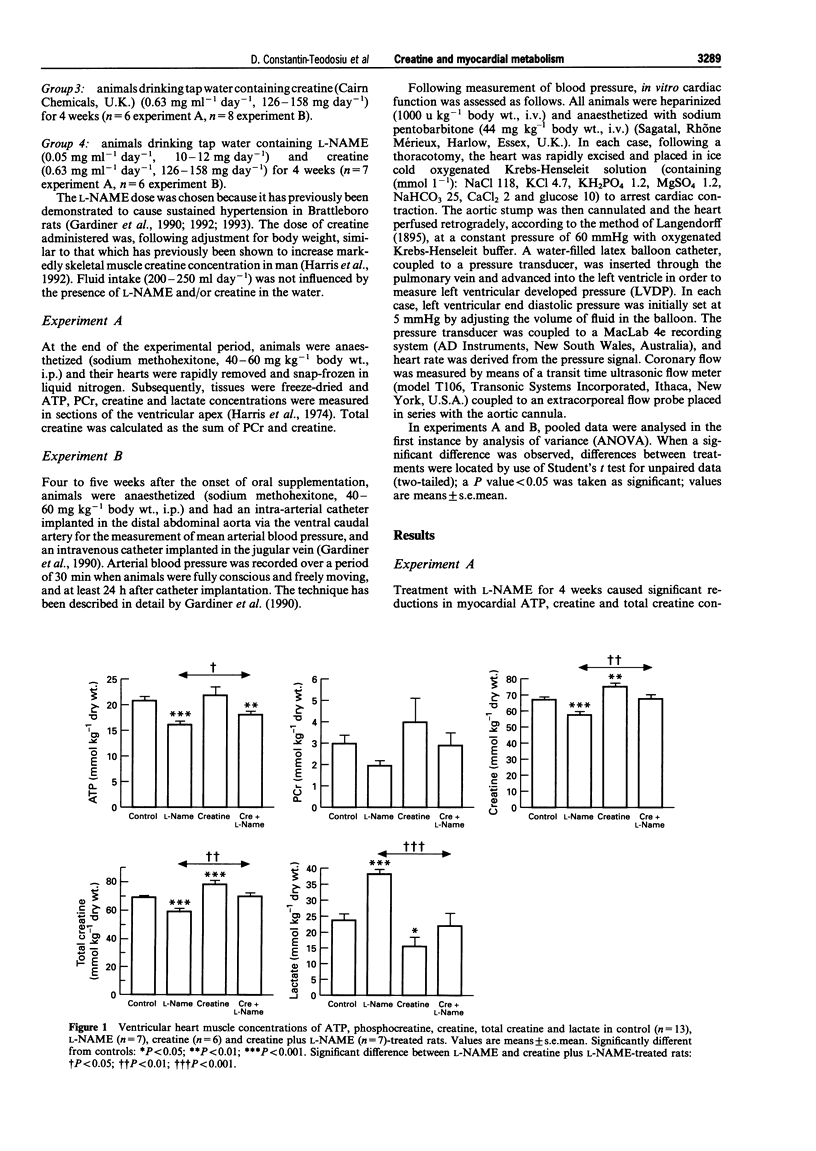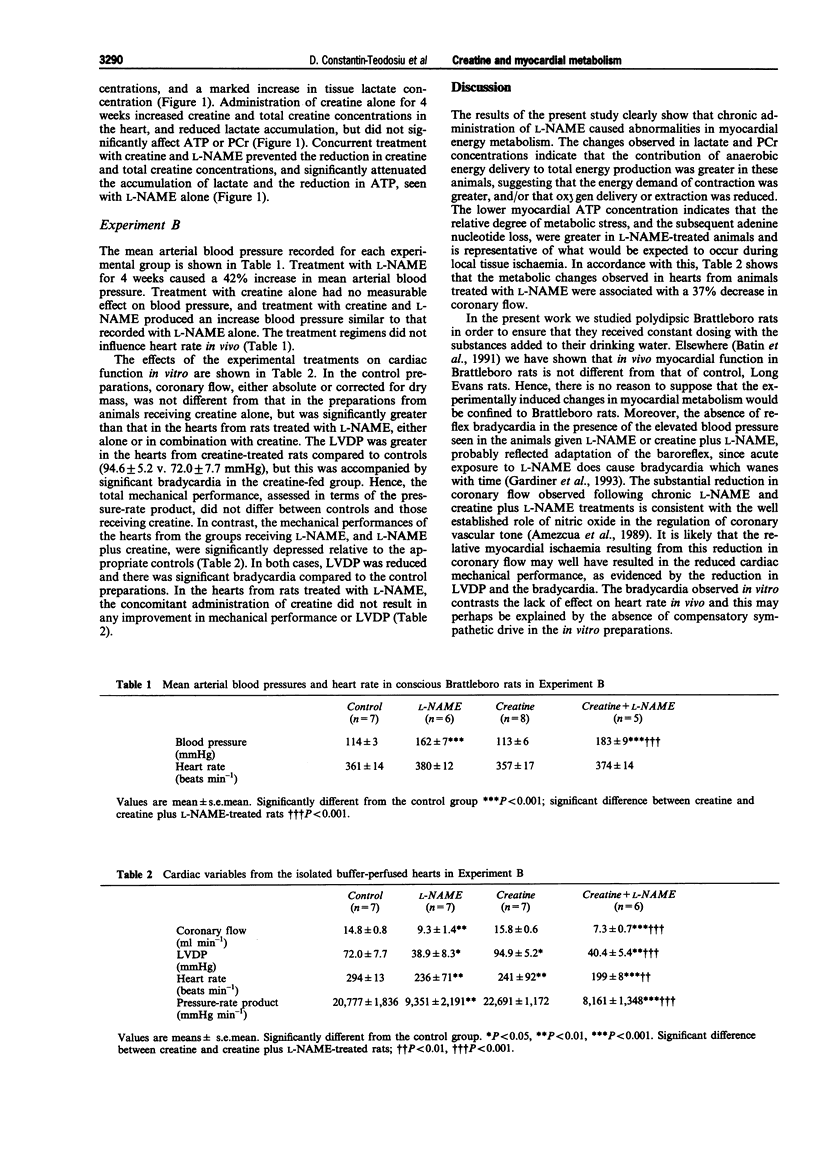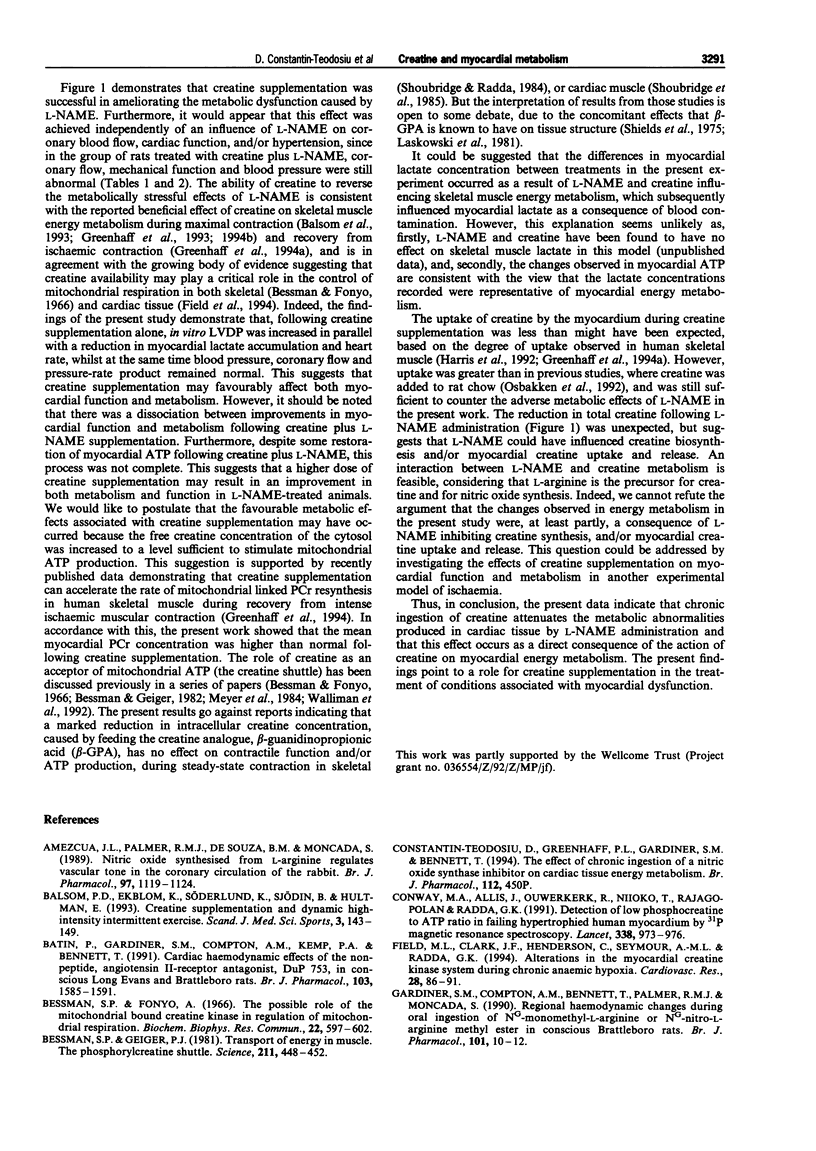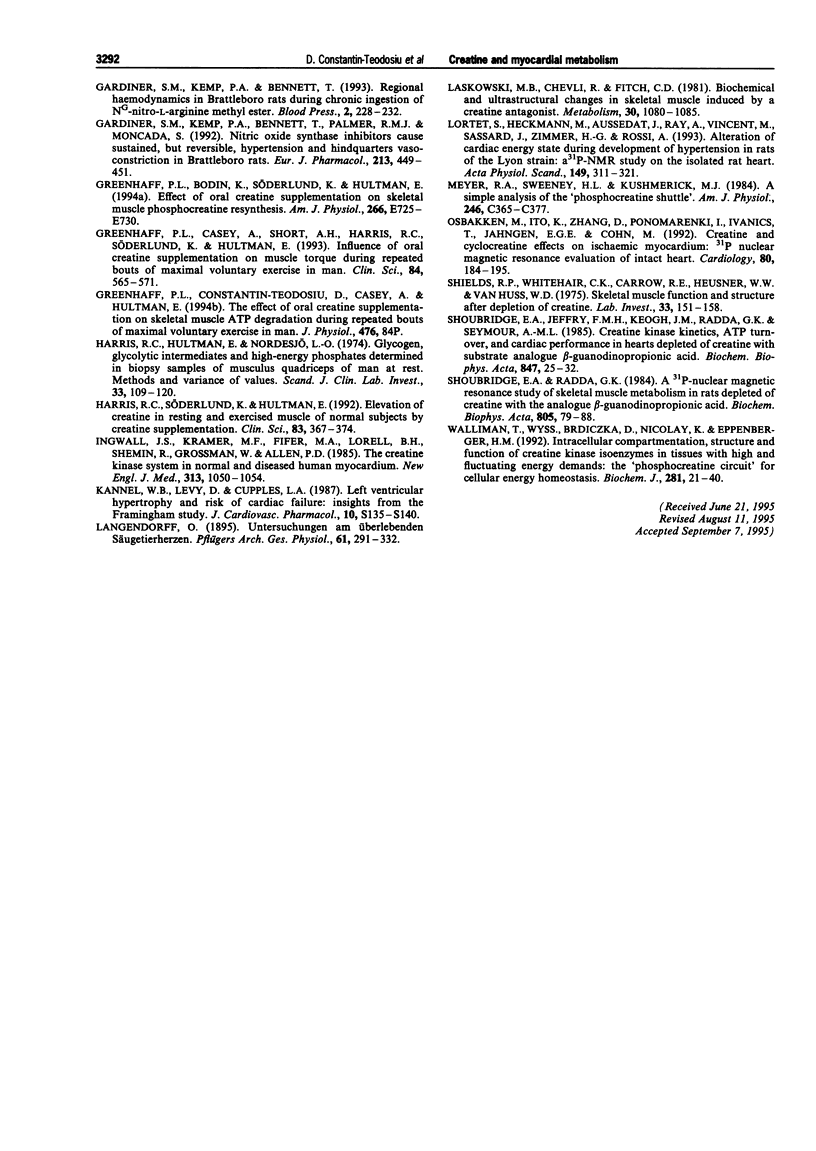Abstract
1. The present experiment was undertaken to investigate: (a) the effect of nitric oxide synthase (NOS) inhibition, mediated by oral supplementation of the NOS inhibitor, NG-nitro-L-arginine methyl ester (L-NAME), on measures of myocardial energy metabolism and function: (b) the effect of oral creatine supplementation on these variables, in the absence and presence of L-NAME. 2. In one series of experiments, 4 weeks oral administration of L-NAME (0.05 mg ml-1 day-1 in the drinking water) to Brattleboro rats caused significant reductions in myocardial ATP, creatine, and total creatine concentrations and an accumulation of tissue lactate when compared with control animals. Administration of creatine (0.63 mg ml-1 day-1 in the drinking water) for 4 weeks elevated myocardial creatine and total creatine concentrations and reduced lactate accumulation, but did not significantly affect ATP or phosphocreatine (PCr). Concurrent treatment with creatine and L-NAME prevented the reduction in creatine and total creatine concentrations, and significantly attenuated the accumulation of lactate and the reduction in ATP seen with L-NAME alone. 3. In a second series of experiments, 4 weeks treatment with L-NAME and creatine plus L-NAME increased mean arterial blood pressure in conscious Brattleboro rats. Hearts isolated from these animals showed decreased coronary flow and left ventricular developed pressure (LVDP), and total mechanical performance. Treatment with creatine alone had no measurable effect on either mean arterial blood pressure or coronary flow in isolated hearts. However, there was an increase in LVDP, but not in total mechanical performance, because there was a bradycardia. 4. These results indicate that creatine supplementation can attenuate the metabolic stress associated with L-NAME administration and that this effect occurs as a consequence of the action of creatine on myocardial energy metabolism.
Full text
PDF




Selected References
These references are in PubMed. This may not be the complete list of references from this article.
- Amezcua J. L., Palmer R. M., de Souza B. M., Moncada S. Nitric oxide synthesized from L-arginine regulates vascular tone in the coronary circulation of the rabbit. Br J Pharmacol. 1989 Aug;97(4):1119–1124. doi: 10.1111/j.1476-5381.1989.tb12569.x. [DOI] [PMC free article] [PubMed] [Google Scholar]
- Batin P., Gardiner S. M., Compton A. M., Kemp P. A., Bennett T. Cardiac haemodynamic effects of the non-peptide, angiotensin II-receptor antagonist, DuP 753, in conscious Long Evans and Brattleboro rats. Br J Pharmacol. 1991 Jun;103(2):1585–1591. doi: 10.1111/j.1476-5381.1991.tb09831.x. [DOI] [PMC free article] [PubMed] [Google Scholar]
- Bessman S. P., Fonyo A. The possible role of the mitochondrial bound creatine kinase in regulation of mitochondrial respiration. Biochem Biophys Res Commun. 1966 Mar 8;22(5):597–602. doi: 10.1016/0006-291x(66)90317-2. [DOI] [PubMed] [Google Scholar]
- Bessman S. P., Geiger P. J. Transport of energy in muscle: the phosphorylcreatine shuttle. Science. 1981 Jan 30;211(4481):448–452. doi: 10.1126/science.6450446. [DOI] [PubMed] [Google Scholar]
- Conway M. A., Allis J., Ouwerkerk R., Niioka T., Rajagopalan B., Radda G. K. Detection of low phosphocreatine to ATP ratio in failing hypertrophied human myocardium by 31P magnetic resonance spectroscopy. Lancet. 1991 Oct 19;338(8773):973–976. doi: 10.1016/0140-6736(91)91838-l. [DOI] [PubMed] [Google Scholar]
- Field M. L., Clark J. F., Henderson C., Seymour A. M., Radda G. K. Alterations in the myocardial creatine kinase system during chronic anaemic hypoxia. Cardiovasc Res. 1994 Jan;28(1):86–91. doi: 10.1093/cvr/28.1.86. [DOI] [PubMed] [Google Scholar]
- Gardiner S. M., Compton A. M., Bennett T., Palmer R. M., Moncada S. Regional haemodynamic changes during oral ingestion of NG-monomethyl-L-arginine or NG-nitro-L-arginine methyl ester in conscious Brattleboro rats. Br J Pharmacol. 1990 Sep;101(1):10–12. doi: 10.1111/j.1476-5381.1990.tb12079.x. [DOI] [PMC free article] [PubMed] [Google Scholar]
- Gardiner S. M., Kemp P. A., Bennett T., Palmer R. M., Moncada S. Nitric oxide synthase inhibitors cause sustained, but reversible, hypertension and hindquarters vasoconstriction in Brattleboro rats. Eur J Pharmacol. 1992 Mar 31;213(3):449–451. doi: 10.1016/0014-2999(92)90636-i. [DOI] [PubMed] [Google Scholar]
- Gardiner S. M., Kemp P. A., Bennett T. Regional haemodynamics in Brattleboro rats during chronic ingestion of NG-nitro-L-arginine methyl ester. Blood Press. 1993 Sep;2(3):228–232. doi: 10.3109/08037059309077556. [DOI] [PubMed] [Google Scholar]
- Greenhaff P. L., Bodin K., Soderlund K., Hultman E. Effect of oral creatine supplementation on skeletal muscle phosphocreatine resynthesis. Am J Physiol. 1994 May;266(5 Pt 1):E725–E730. doi: 10.1152/ajpendo.1994.266.5.E725. [DOI] [PubMed] [Google Scholar]
- Greenhaff P. L., Casey A., Short A. H., Harris R., Soderlund K., Hultman E. Influence of oral creatine supplementation of muscle torque during repeated bouts of maximal voluntary exercise in man. Clin Sci (Lond) 1993 May;84(5):565–571. doi: 10.1042/cs0840565. [DOI] [PubMed] [Google Scholar]
- Harris R. C., Hultman E., Nordesjö L. O. Glycogen, glycolytic intermediates and high-energy phosphates determined in biopsy samples of musculus quadriceps femoris of man at rest. Methods and variance of values. Scand J Clin Lab Invest. 1974 Apr;33(2):109–120. [PubMed] [Google Scholar]
- Harris R. C., Söderlund K., Hultman E. Elevation of creatine in resting and exercised muscle of normal subjects by creatine supplementation. Clin Sci (Lond) 1992 Sep;83(3):367–374. doi: 10.1042/cs0830367. [DOI] [PubMed] [Google Scholar]
- Ingwall J. S., Kramer M. F., Fifer M. A., Lorell B. H., Shemin R., Grossman W., Allen P. D. The creatine kinase system in normal and diseased human myocardium. N Engl J Med. 1985 Oct 24;313(17):1050–1054. doi: 10.1056/NEJM198510243131704. [DOI] [PubMed] [Google Scholar]
- Kannel W. B., Levy D., Cupples L. A. Left ventricular hypertrophy and risk of cardiac failure: insights from the Framingham Study. J Cardiovasc Pharmacol. 1987;10 (Suppl 6):S135–S140. [PubMed] [Google Scholar]
- Laskowski M. B., Chevli R., Fitch C. D. Biochemical and ultrastructural changes in skeletal muscle induced by a creatine antagonist. Metabolism. 1981 Nov;30(11):1080–1085. doi: 10.1016/0026-0495(81)90051-2. [DOI] [PubMed] [Google Scholar]
- Lortet S., Heckmann M., Aussedat J., Ray A., Vincent M., Sassard J., Zimmer H. G., Rossi A. Alteration of cardiac energy state during development of hypertension in rats of the Lyon strain: a 31P-NMR study on the isolated rat heart. Acta Physiol Scand. 1993 Nov;149(3):311–321. doi: 10.1111/j.1748-1716.1993.tb09626.x. [DOI] [PubMed] [Google Scholar]
- Meyer R. A., Sweeney H. L., Kushmerick M. J. A simple analysis of the "phosphocreatine shuttle". Am J Physiol. 1984 May;246(5 Pt 1):C365–C377. doi: 10.1152/ajpcell.1984.246.5.C365. [DOI] [PubMed] [Google Scholar]
- Osbakken M., Ito K., Zhang D., Ponomarenko I., Ivanics T., Jahngen E. G., Cohn M. Creatine and cyclocreatine effects on ischemic myocardium: 31P nuclear magnetic resonance evaluation of intact heart. Cardiology. 1992;80(3-4):184–195. doi: 10.1159/000175002. [DOI] [PubMed] [Google Scholar]
- Shields R. P., Whitehair C. K., Carrow R. E., Heusner W. W., Van Huss W. D. Skeletal muscle function and structure after depletion of creatine. Lab Invest. 1975 Aug;33(2):151–158. [PubMed] [Google Scholar]
- Shoubridge E. A., Jeffry F. M., Keogh J. M., Radda G. K., Seymour A. M. Creatine kinase kinetics, ATP turnover, and cardiac performance in hearts depleted of creatine with the substrate analogue beta-guanidinopropionic acid. Biochim Biophys Acta. 1985 Oct 30;847(1):25–32. doi: 10.1016/0167-4889(85)90148-x. [DOI] [PubMed] [Google Scholar]
- Shoubridge E. A., Radda G. K. A 31P-nuclear magnetic resonance study of skeletal muscle metabolism in rats depleted of creatine with the analogue beta-guanidinopropionic acid. Biochim Biophys Acta. 1984 Sep 14;805(1):79–88. doi: 10.1016/0167-4889(84)90039-9. [DOI] [PubMed] [Google Scholar]
- Wallimann T., Wyss M., Brdiczka D., Nicolay K., Eppenberger H. M. Intracellular compartmentation, structure and function of creatine kinase isoenzymes in tissues with high and fluctuating energy demands: the 'phosphocreatine circuit' for cellular energy homeostasis. Biochem J. 1992 Jan 1;281(Pt 1):21–40. doi: 10.1042/bj2810021. [DOI] [PMC free article] [PubMed] [Google Scholar]


